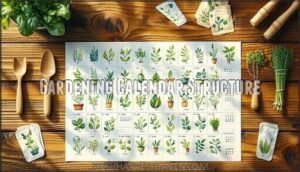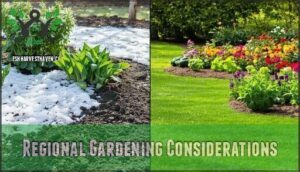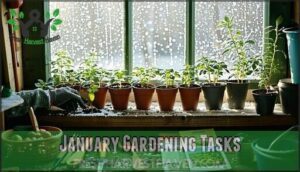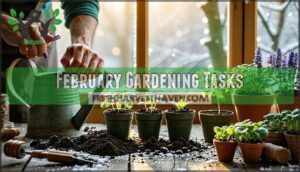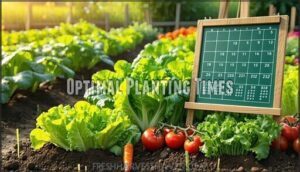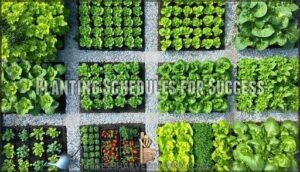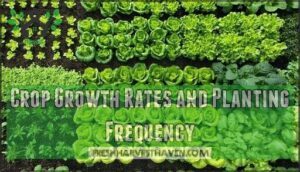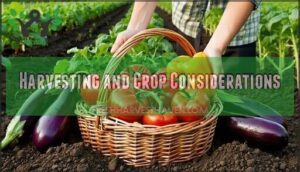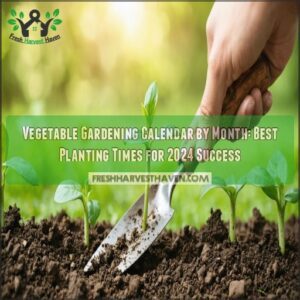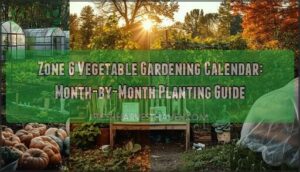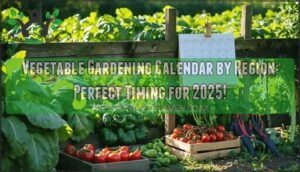This site is supported by our readers. We may earn a commission, at no cost to you, if you purchase through links.
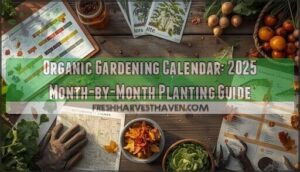 Your organic gardening calendar becomes your roadmap to year-round success. Start by testing soil pH monthly and tracking frost dates for your region.
Your organic gardening calendar becomes your roadmap to year-round success. Start by testing soil pH monthly and tracking frost dates for your region.
Plan succession plantings every 2-3 weeks for continuous harvests of lettuce, beans, and radishes. Schedule compost tea applications when soil hits 50°F to wake up beneficial microbes.
Deep morning watering beats frequent shallow sessions every time. Rotate crops annually to prevent disease buildup and maintain soil health.
Check under leaves weekly for pest early warning signs. Clean tools after each use to stop disease spread.
Your calendar adapts to local conditions – coastal areas get 2-3 extra weeks compared to inland zones. Smart timing transforms scattered efforts into productive harvests, ensuring year-round success with beneficial microbes.
Table Of Contents
- Key Takeaways
- Organic Gardening Basics
- Gardening Calendar Structure
- Regional Gardening Considerations
- Gardening Tasks and Schedules
- Planting Calendar Optimization
- Frequently Asked Questions (FAQs)
- . Why Should You Start Seeds indoors?
- . Which Seeds Should You Start indoors?
- . When Should You Start Seeds indoors?
- . When Should You Transplant seedlings?
- . Why Should You Start Seeds indoors?
- . Which Seeds Should You Start indoors?
- . When Should You Start Seeds indoors?
- . When Should You Transplant seedlings?
- What is the gardening 3 year rule?
- What vegetables to plant in what month?
- Conclusion
Key Takeaways
- Test your soil monthly and track frost dates – You’ll create a solid foundation by monitoring pH levels regularly and knowing your region’s specific frost timeline for optimal planting windows.
- Use succession planting every 2-3 weeks – You’ll maintain continuous harvests of lettuce, beans, and radishes instead of dealing with overwhelming gluts or empty garden periods.
- Schedule compost tea applications when soil hits 50°F – You’ll wake up beneficial microbes at the right time, giving your plants the natural nutrition boost they need for healthy growth.
- Rotate crops annually and inspect plants weekly – You’ll prevent disease buildup, maintain soil health, and catch pest problems early before they damage your harvest.
Organic Gardening Basics
Creating a successful organic garden starts with understanding your plants’ basic needs and timing your tasks correctly.
You’ll organize your year around monthly projects like soil preparation and seeding schedules, while keeping detailed notes about what works best in your specific growing conditions, focusing on complete concepts.
Monthly Garden Projects
Smart monthly garden projects keep you ahead of nature’s curve. Your seasonal gardening guide becomes your roadmap to success when you tackle tasks at the right moment.
Garden Planning starts with mapping your space and choosing varieties. Soil Testing reveals what nutrients you’ll need to add. Weed Control works best when you prevent problems rather than chase them. Pruning Tips change with each season—dormant season for fruit trees, deadheading for flowers. Harvest Management means picking at peak ripeness and storing properly.
Your organic gardening calendar should track:
- Monthly soil pH and nutrient testing
- Crop rotation schedules to prevent disease
- Succession planting dates for continuous harvests
- Pest monitoring and beneficial insect counts
- Compost pile maintenance with proper ratios.
Gardening by month with structured tasks means you’ll never miss critical windows.
Customized Notes Section
Beyond basic planting schedules, your organic gardening calendar needs a dedicated space for record keeping.
Create sections for note taking about soil conditions, weather patterns, and pest observations. Document which gardening tips worked best in your specific conditions.
Track seed varieties, planting dates, and harvest yields to improve future garden planning. Your personalized gardening calendar becomes invaluable when you record germination rates, companion planting successes, and seasonal challenges.
These garden notes transform casual observations into strategic garden tracking data. Effective gardening journaling with specific journaling ideas turns your calendar into a powerful reference tool for mastering organic growing techniques.
Category What to Track
Seeding Schedules for Flowers and Vegetables
Three essential timing strategies reveal your garden’s full potential throughout 2025.
Cool-season vegetables need that critical 4-6 week head start before your last frost dates. Warm-season crops won’t budge until soil temperatures hit 60°F consistently.
Nature’s timing beats your schedule every time—work with the seasons, not against them
Your seed starting schedule becomes the backbone of continuous harvests.
- Seed Starting: Time indoor sowing to match frost dates and soil temperature requirements
- Crop Rotation: Rotate vegetable families annually to maintain soil health and break pest cycles
- Garden Planning: Stagger planting schedules for continuous harvests throughout the growing season
Germination rates depend heavily on proper timing. Your planting calendar should account for each crop’s temperature preferences.
Cool crops like lettuce thrive in 50°F soil, while tomatoes demand warmth.
This organic gardening approach maximizes your vegetable gardening calendar success by working with nature’s rhythm instead of against it.
Understanding soil health benefits is vital for a thriving garden ecosystem.
Gardening Calendar Structure
A well-structured gardening calendar transforms scattered planting ideas into a clear seasonal roadmap that maximizes your harvest potential.
Your calendar should include weekly task reminders, specific seeding dates, fertilizing schedules, and lawn maintenance notes to keep your organic garden thriving year-round.
Weekly Gardening Tasks
Weekly tasks keep your organic garden healthy without overwhelming your schedule.
Soil Checks involve testing moisture two inches deep—dry soil means it’s watering time. Water Management focuses on deep, morning watering rather than frequent sprinkles.
Pest Control means weekly inspections under leaves for early problem detection. Tool Maintenance includes cleaning equipment after each use to prevent disease spread.
Garden Planning updates help you track progress and schedule next week’s projects. These consistent weekly gardening tasks form your garden calendar foundation, supporting successful gardening by month with proven organic gardening tips.
Effective garden management also requires understanding of seasonal gardening techniques to guarantee a thriving garden throughout the year.
Seeding and Planting Dates
Timing your seed starting correctly separates successful gardens from disappointing ones.
Your planting calendar becomes your blueprint for maximum harvests when you match planting dates with soil temperatures and frost dates.
- Start cool-season crops 4-6 weeks before your last frost dates
- Wait for 60°F soil before warm-season seed starting
- Track germination rates to adjust future seeding schedules
- Use succession planting every 2 weeks for continuous harvests
- Monitor planting times with a soil thermometer for accuracy
Fertilizing Schedules
Effective fertilizing schedules turn your organic gardening calendar into a strategic nutrition plan.
Soil testing reveals what your plants actually need, not what you think they need.
Here’s your timing guide for organic fertilizer recipes and nutrient cycling:
- Spring awakening: Apply compost tea when soil hits 50°F to activate beneficial microbes
- Pre-plant prep: Work slow-release fertilizer into beds 2-3 weeks before transplanting seedlings
- Mid-season boost: Side-dress heavy feeders with balanced organic fertilizers during peak growth
- Late summer shift: Switch to low-nitrogen blends to prepare plants for dormancy
- Fall restoration: Add composted manure for nutrient cycling and soil health renewal
Smart manure management and fertilizer types prevent both deficiencies and over-fertilization disasters.
Understanding summer gardening principles is essential for maintaining a healthy and thriving garden ecosystem.
Lawn Maintenance Reminders
Your gardening calendar keeps your lawn healthy with strategic maintenance reminders.
Mowing tips suggest cutting grass at proper heights for root strength. Lawn aeration breaks up compacted soil, while edge trimming creates clean borders. Fertilizer application feeds grass naturally, and weed control protects without chemicals.
| Month | Primary Task | Organic Method |
|---|---|---|
| March | Lawn Aeration | Core aeration tool |
| April | Fertilizer Application | Compost tea spray |
| May | Weed Control | Hand pulling/mulch |
| June | Mowing Tips | High blade setting |
| July | Edge Trimming | Manual edging tool |
Regional Gardening Considerations
Your region’s climate patterns determine when you can safely plant and harvest your crops throughout the year.
Understanding your local frost dates and USDA hardiness zone helps you customize planting schedules for maximum success in your specific area.
Northeastern United States Climate
Anyone can master the Northeastern United States Climate with proper planning. This region spans USDA Zones 5-7, creating complex microclimates within short distances. Your organic gardening calendar becomes essential when managing these challenging conditions.
Regional patterns show significant temperature swings and unpredictable weather. Consider these climate customization factors:
- Frost dates vary by 2-3 weeks between coastal and inland areas
- Urban heat islands extend growing seasons in cities
- Sudden late frosts threaten April and May plantings
- Heavy spring rains require improved drainage solutions
- Summer humidity increases disease pressure on crops
USDA hardiness maps provide your foundation, but local microclimates determine success. Track your specific gardening zones for the best results to achieve successful gardening.
Customization Based on Last Frost Dates
If you want your organic garden to thrive, customizing your planting schedule around frost dates is essential.
Frost date impact can make or break your crops, so use these strategies:
- Work backward from frost dates to set seed starting times
- Adjust planting schedules for your gardening zones and climate zones
- Map microclimate adjustments for your yard’s quirks
- Choose variety selection that matches your region’s conditions
- Plan succession planting and protection methods for frost-free periods
Get precise, and your regional gardening results will show it.
Understanding your USDA hardiness zone is also vital for selecting appropriate plants.
Future Regional Calendars
Beyond merely adapting to your local conditions, Future Regional Calendars will transform how you approach Climate Zone gardening through advanced Data Integration and Calendar Personalization.
These innovative tools address Climate Change Impact by using Predictive Modeling to optimize your garden’s success across diverse Microclimates.
Future Regional Calendars deliver precise Regional Gardening Considerations through sophisticated Resource Optimization features:
- Smart frost date algorithms that automatically adjust your Frost Date Planning based on evolving weather patterns
- Microclimate mapping technology that customizes recommendations for your exact location’s unique conditions
- Predictive crop scheduling that anticipates seasonal variations to maximize your harvest timing and garden productivity
Planting Times Based on Regional Climate
Climate zones reveal your planting potential. Your location’s USDA Zones and Microclimates Impact determine everything from soil warming to Seasonal Variations in growing seasons.
Frost Dates aren’t suggestions—they’re your garden’s lifeline. Late spring freezes can destroy months of planning, while early fall frosts cut harvests short. Watering Needs also shift dramatically between regions.
Smart gardeners track these patterns:
- Monitor soil temperature before planting warm-season crops
- Identify protected spots that extend your growing window
- Adjust planting schedules for your specific regional climate
Your climate zones shape success more than any technique or tool.
Gardening Tasks and Schedules
Your organic garden needs consistent attention throughout the growing season to thrive and produce healthy harvests.
Following a monthly task schedule keeps you organized and helps you complete essential activities like soil preparation, planting, and pest management at the right times, ensuring you can maintain a successful and thriving garden through proper pest management.
January Gardening Tasks
January sets your organic gardening calendar in motion with essential January gardening tasks that determine your season’s success. Start garden planning by reviewing last year’s notes and mapping crop rotations. Order from seed catalogs early—the best varieties disappear fast.
Tool cleaning tops your priority list. Sharp, clean tools prevent disease spread and make work easier. Oil wooden handles and sharpen blades now.
Dormant pruning transforms your fruit trees and berry bushes. Cut while they’re sleeping to encourage vigorous spring growth. Remove dead or crossing branches first.
Indoor sowing begins with cool-season crops like lettuce, kale, and onions. These hardy vegetables need early starts for spring transplanting.
Test your soil pH and nutrients while beds rest. Add compost or organic matter based on results. Protect tender perennials with mulch or covers. Remember to control winter weeds with broadleaf herbicide on warmer days.
These monthly garden projects create the foundation for your entire growing season.
February Gardening Tasks
February brings fresh energy to your organic gardening journey. While winter still holds its grip, you can break free from the dormant season and start building momentum for spring’s abundance.
February Gardening Tasks reveal your garden’s potential through strategic preparation:
- Indoor Seed Starting – Sow cool-season crops like broccoli, kale, and cabbage in sterile potting mix for transplanting after the last frost
- Dormant Pruning – Trim fruit trees and berry bushes before buds swell, removing dead wood and improving air circulation
- Early Bed Prep – Test soil pH and work compost into beds as Soil Thawing begins, creating nutrient-rich growing areas
- Tool Maintenance – Sharpen pruners, clean shovels, and oil wooden handles while you have time
These February activities set your organic gardening foundation. Focus on soil preparation and seed starting now, giving your plants the head start they need. Your planting schedules depend on this groundwork.
March Gardening Tasks
March’s promise lies in soil warming and early sowing opportunities. Start your Spring cleanup by testing soil pH and adding compost for ideal Soil Preparation. Begin Early sowing of cool-season crops like peas and spinach once soil becomes workable. Seed germination improves as temperatures rise, making this perfect timing for starting tomatoes and peppers indoors.
Focus on Frost protection strategies using row covers or cold frames. Clear winter debris and plan your Planting Schedules based on your last frost date. These March Gardening Tasks set your garden’s foundation for success.
April Gardening Tasks
As spring arrives, April gardening tasks reveal your garden’s potential for abundant harvests ahead.
Your organic gardening foundation starts with strategic soil preparation and mindful plant care.
- Seedling Hardening: Gradually expose indoor seedlings to outdoor conditions over 7-10 days, strengthening them for transplanting success.
- Soil Amendments: Mix compost into planting beds and test pH levels, creating nutrient-rich environments for healthy root development.
- Pest Monitoring: Inspect plants weekly for early pest signs while establishing watering needs for newly planted flowers and vegetables.
These April gardening tasks guarantee your planting schedules stay on track throughout the growing season.
May Gardening Tasks
Several key May Tasks will set your garden up for summer success.
Begin Seedling hardening by gradually exposing indoor starts to outdoor conditions over seven days.
Focus on Pest monitoring—inspect plants daily for aphids, caterpillars, and early disease signs.
Summer prep includes installing support systems for climbing crops and checking Irrigation needs as temperatures rise.
Continue Late sowing of heat-tolerant greens like spinach and lettuce for extended harvests.
Your Planting Schedules should prioritize warm-season vegetables once soil reaches 60°F.
These May Gardening Tasks require daily attention, but your effort pays off with robust plants ready for summer’s heat.
Planting Calendar Optimization
You’ll maximize your garden’s productivity by timing plantings perfectly and choosing varieties that resist common problems like bolting.
Strategic scheduling guarantees continuous harvests while preventing overwhelming gluts that leave you scrambling to preserve excess produce.
Optimal Planting Times
Your garden’s success depends on perfect timing. When you nail perfect planting times, you’ll release nature’s full potential and harvest abundance.
Understanding these timing factors transforms your organic gardening calendar from guesswork into precision:
- Frost Date Impact: Know your last spring frost to protect tender seedlings from deadly temperature drops.
- Soil Temperature Needs: Seeds won’t germinate in cold soil. Warm-season crops need 60°F+ while cool-season varieties tolerate lower temperatures.
- Succession Planting: Stagger plantings every two weeks to maintain continuous harvests rather than overwhelming gluts.
- Regional Variations: Your USDA zone determines when soil warms and growing seasons begin, making local adaptation key.
Seasonal planting windows change dramatically across regions. Utilizing a summer vegetable planting guide can greatly assist in choosing the right crops. Lunar planting cycles can guide your timing decisions, though soil conditions matter most. Your planting schedules should reflect these natural rhythms for maximum productivity.
Planting Schedules for Success
Smart planning transforms your garden from chaos to abundance.
Your planting calendar becomes your roadmap to success when you master timing.
Start cool-season crops before your last frost dates, then switch to warm-season varieties once soil temperature reaches 60°F.
Succession planting every two weeks guarantees continuous harvests rather than overwhelming gluts.
Crop rotation annually prevents soil depletion and breaks pest cycles.
Choose regional varieties adapted to your climate for better yields and disease resistance.
Track your optimal planting windows and stick to proven planting times for each crop.
Seasonal planting schedules keep you organized and productive year-round.
Crop Growth Rates and Planting Frequency
Master your garden’s natural rhythm by understanding how fast your crops grow and when to plant them again.
Lettuce reaches harvest size in 30-45 days, while radishes sprint to maturity in just 22-35 days. Bush beans need 50-70 days, and carrots take their time at 60-80 days. These Growth Rate Factors determine your Planting Frequency and shape your entire garden strategy.
Here’s how to optimize your Crop Growth Rates:
- Track maturity dates – Know each variety’s days to harvest for perfect Harvest Timing
- Plan Succession Plantings – Sow lettuce every 10-15 days for continuous harvests
- Adjust Planting Density – Give fast growers like radishes closer spacing than slow carrots
- Time your Harvest Windows – Remove spent crops immediately and replant for 60% higher yields
- Choose smart Variety Selection – Pick varieties matched to your growing season length
Smart Planting Schedules based on actual growth patterns keep your garden productive year-round. Understanding factors affecting plant growth is essential for maximum yields.
Resistance to Bolting for Extended Harvest
Bolting prevention starts with choosing heat-tolerant varieties like ‘Buttercrunch’ lettuce and ‘Tyee’ spinach, which resist flowering 30% longer than standard types.
These varieties handle temperature stress better, giving you extended harvest windows.
Your watering strategies make the difference. Keep soil consistently moist and mulch heavily to maintain root zone temperatures below 65°F. This simple step delays bolting by up to 10 days.
Smart shading techniques work wonders too. Position leafy greens on the north side of taller plants or use shade cloth during peak summer heat.
Harvesting and Crop Considerations
When harvest timing aligns with peak ripeness, you’ll release your garden’s true potential.
Observation drives success—daily monitoring reveals subtle changes that determine yield optimization.
Crop storage techniques preserve your bounty while succession planting guarantees continuous harvests.
Your harvest timing and crop considerations checklist:
- Check ripeness indicators daily during peak seasons
- Rotate crops annually to maintain soil quality
- Plant every 2-3 weeks for continuous production
- Select disease-resistant varieties for reliable yields
- Test soil pH quarterly to optimize growing conditions
Strategic variety selection paired with proper yield optimization transforms average gardens into productive powerhouses.
Frequently Asked Questions (FAQs)
. Why Should You Start Seeds indoors?
You’ll get a head start on the growing season and extend your harvest window. Indoor seed starting lets you control conditions, save money, and grow varieties unavailable as transplants.
. Which Seeds Should You Start indoors?
Seventy percent of vegetables grown from transplants outperform direct-sown crops.
You’ll want to start warm-season vegetables like tomatoes, peppers, eggplant, and herbs indoors since they need consistent warmth to germinate and establish strong roots before transplanting outside.
. When Should You Start Seeds indoors?
Start seeds indoors 4-6 weeks before your last frost date for cool-season crops, and 6-8 weeks for warm-season vegetables that need transplanting after soil warms.
. When Should You Transplant seedlings?
Transplant seedlings after they’ve developed two to three sets of true leaves and can handle outdoor temperatures. You’ll want to harden them off gradually over seven days before moving permanently.
. Why Should You Start Seeds indoors?
Indoor seeding gives you control, extends seasons, and saves money.
You’ll jumpstart growth before outdoor conditions allow, protect tender seedlings from harsh weather, and choose from wider seed varieties than nurseries offer, which helps with control and saves money.
. Which Seeds Should You Start indoors?
Cool-season crops like tomatoes, peppers, and eggplants need your indoor head start. Warm-season vegetables require controlled temperatures and longer growing seasons that outdoor conditions can’t provide early enough.
. When Should You Start Seeds indoors?
Timing’s everything when freedom calls – you’ll want to count backward from your last frost date. Cool-season crops need that 4-6 week head start indoors before transplanting outside.
. When Should You Transplant seedlings?
Wait until seedlings have at least two sets of true leaves and outdoor soil warms above 60°F.
You’ll dodge late frosts and give roots a fighting chance—think of it as moving day with perfect weather.
What is the gardening 3 year rule?
Like a golden thread weaving through your garden’s story, you’ll rotate crops every three years to prevent nutrient depletion and disease buildup, keeping your soil healthy and productive.
What vegetables to plant in what month?
Plant cool-season crops like lettuce, peas, and spinach in early spring. Start warm-season vegetables like tomatoes, peppers, and squash after your last frost date when soil warms up properly.
Conclusion
Success grows from careful planning.
Your organic gardening calendar transforms seasonal chaos into productive order.
You’ve learned to time plantings, monitor soil health, and schedule maintenance tasks throughout the year.
Track frost dates, rotate crops, and maintain consistent watering schedules.
Apply compost tea when temperatures reach ideal levels.
Check plants weekly for early pest detection.
Your calendar adapts to local conditions and guarantees continuous harvests.
Consistent timing creates thriving gardens year-round, ensuring a thriving garden.
- http://mailto:organicgardeningcalendar
- https://www.ncdc.noaa.gov/cgi-bin/climatenormals/climatenormals.pl?directive=prod_select2&prodtype=CLIM2001&subrnum%2520to%2520Freeze/Frost%2520Data%2520from%2520the%2520U.S.%2520Climate%2520Normals
- https://sowtrueseed.com/blogs/monthly-garden-schedule-by-zone/febuary-garden-chores
- https://www.epicgardening.com/february-gardening-tasks
- https://www.teraganix.com/blogs/organic-gardening-tips/winter-gardening-calendar-your-month-by-month-guide-for-organic-garden-care

